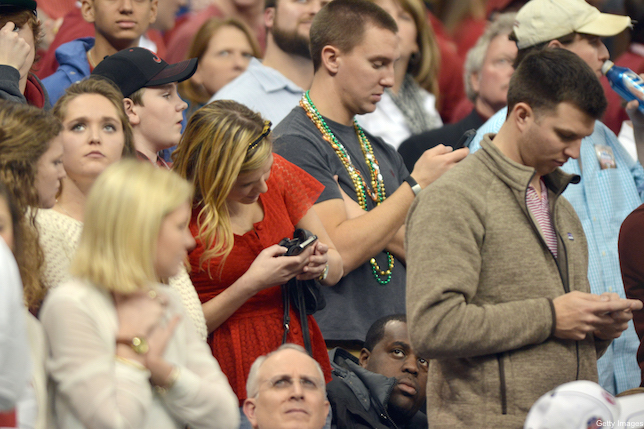The under-30 generation has grown up processing information in a dramatically different manner than their predecessors. Their attention span is shorter, and their need to multi-task is higher. This poses a challenge for collegiate and professional sports to keep these potential fans coming to and enjoying live sporting events. If young people have not played sports themselves or witnessed it live in a jam-packed stadium or arena, eventually the emotional connection with watching televised sports is weakened.
So, imagine a childhood dramatically different than the one some of us grew up in during the 50s and 60s. Our world had black-and-white television with three networks and a few independents showing old movies. The way to change a channel was to walk to the TV and turn the dial. Phones had rotary dials and rang busy when a call was in progress. There were no computers, much less cellphones, texting, Facebook, Twitter, Instagram, Facetime or LinkedIn. The way to reproduce a copy was by mimeographing a copy with a stencil or later a trip to Kinko's. People read books and used their imagination for entertainment.
Today, our youth grow up on big screen high-definition pictures, available on 350 competing channels. Vivid color and sound, and is fast cutting. It is possible to create their own content, or use the television monitor for other programming.
Young people learn to use iPads in infancy. They multitask on computer screens and cellphones, switching from stimuli to stimulus -- texting, tweeting, Facebooking, Instragramming, YouTubing, playing video games with headsets, creating viral affinity groups. There is an illusion that every second of sensory input can be controlled through the fingers. Twitching thumbs accompany every second. Attention span and patience are attenuated. Interactivity is prized.

The sports remedy? Creating stadia and arenas which are filled with multiple attractions. Jumbo scoreboards filled with quizzes, Kiss-cams, every form of clearly designed entertainment. Making the physical design of the stadium filled with activity zones. A winning baseball team is still going to lose quite a few games. Going to see a game in person needs to be exciting notwithstanding the result on the field. Wiring stadia and arenas with Wi-Fi is a necessity. Every form of creativity needs to be employed to find alternative stimuli. Crowdsourcing analytics can be employed to track user experiences.
Remember that a football game is filled with endless TV commercial timeouts, insufferable delays for instant replay, two-minute warnings, breaks for quarters and halftime -- generally nothing is happening on the field. A 60-minute football game stretches beyond three hours and actual play on the field is minimized.
For a younger generation a monitor should be put in front of each seat in a stadium or arena. Down one side streams the users fantasy team and how the game affects their standings. The other side can stream the progress of their wagers on different games. We allow the fans to vote on one referee call they can overturn. There is an on-screen texting feature that allows fans to "talk smack" with others inside and out of the stadium. They could send pictures to friends. They also could suggest one play call that the coach needs to call. Touching the monitor allows a fan to order from the snack bar. Endless content can be programmed through the screen that allows fan interactivity. Ultimately it leads to a full menu of product and experience inventory that can be monetized.
Fans that are purists and simply want to focus on the play on the field, and discussions regarding it, are still free to enjoy the game in a traditional way. But for a generation that needs a higher degree of activity and stimulus -- a ballpark needs to be updated to keep them engaged.

-- Leigh Steinberg has represented many of the most successful athletes and coaches in football, basketball, baseball, hockey, boxing and golf, including the first overall pick in the NFL draft an unprecedented eight times, among more than 60 first-round selections. His clients have included Hall of Fame quarterbacks Steve Young, Troy Aikman and Warren Moon, and he served as the inspiration for the movie "Jerry Maguire." Follow him on Twitter @leighsteinberg.





